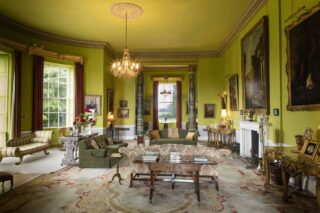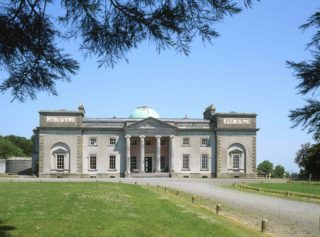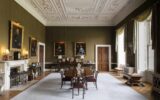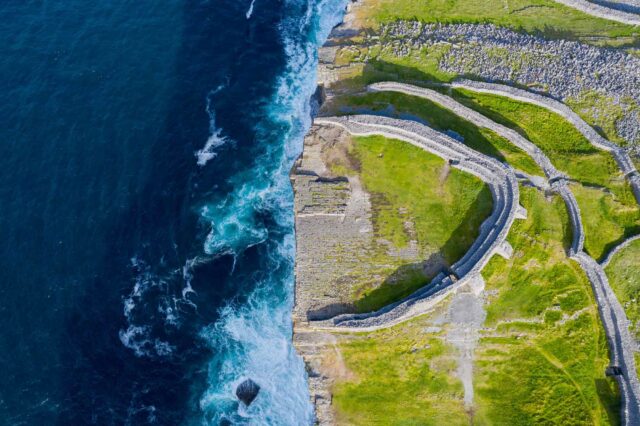
The magnificent neoclassical splendour of Emo Court was home to the earls of Portarlington for six generations. The house, surrounded by gardens and parkland with formal lawns, lake and indigenous woodland, was commissioned by John Dawson, first earl of Portarlington, in 1790. It is one of only a few private houses designed by the celebrated architect James Gandon and the only building he designed outside of Dublin. However, the construction of the house was beset with setbacks from the beginning. By the time of Lord Portarlington’s unexpected death in 1798, only the shell of the house had been constructed. It took another 80 years and the work of a number of other architects before the building was finally completed.
Emo Court’s later history, however, would witness a new era far removed from its intended use as a luxurious country villa. The grand house was sold to the Jesuit order in 1930 to be used as a novitiate, a place where members would receive spiritual and intellectual training and guidance. Firmly embracing their renowned ethos of educational and civic work, the Jesuits ran their novitiate at Emo Court for almost half a century. This new beginning would bring sweeping changes to the house, heralding a new chapter in its long but ultimately fortuitous history.
Following the departure of the Dawson-Damer family to England and the sale of the house and its demense of over 11,000 acres to the Irish Land Commission in 1920, Emo Court lay empty for a decade. Its contents were auctioned off and the house quickly fell into disrepair, reduced to a shadow of its former self. Second only to the Phoenix Park in Dublin, it remained the largest enclosed estate in the country. Much of the original estate was retained by the Land Commission and let out to local farmers, while a School of Forestry also operated on the estate. The house and about 60 acres of gardens and woodlands were put up for sale. It was the peaceful seclusion offered by the house that appealed to the Society of Jesus (the Jesuits), who were in search of a new novitiate house and in early 1930 the sale was finalised. Emo Court then became known as St Mary’s, Emo.

In taking on such a large historic house in economically difficult times, the Jesuits had a colossal task ahead of them, not just in terms of converting the building, but also in terms of the responsibility they carried in maintaining a piece of Irish history. Immediate repairs and rebuilding were carried out to undo years of neglect, while central heating and washing facilities were installed and bedrooms converted into dormitories. But the interior required significant modification and structural changes to transform it from a family residence to a place of worship and learning. A chapel, sanctuary, refectory and assembly room were just some of the essential requirements for the Jesuit novices. But perhaps the most important task and greatest challenge was the creation of the chapel. This was achieved by amalgamating the rotunda and what is now the library, by removing walls, columns, doors, an inlaid floor and a rococo chimneypiece. Such changes were potentially catastrophic to the building, but fortunately the Jesuits had the presence of mind to preserve anything that was removed, carefully storing these pieces in the basement. At the east end of the house, the ballroom witnessed similar transformations, where marble columns were removed and stored. This room became the community refectory, while the dining room was converted into a conference room. Outside, the grounds were converted into a productive farm, orchard and playing fields.
St Marys, Emo was now ready to accept its first Jesuit novices and, on 4 August 1930, the house opened as the Novitiate of the Irish Province. Novices transferred from St Stanislaus College in Tullamore and, in the first year alone, there were 52 novices. Over the following decades more than 500 novices trained at Emo. A Jesuit’s formation began in the novitiate, where he spent two years learning how to pray, how to live in community and about the Society of Jesus. This novitiate programme essentially centred on prayer, study, reflection and meditation. Essential to Jesuit training was the development of prayer life and, in addition to the daily celebration of mass, novices prayed three times a day – in the morning, at midday and in the evening. They read and learned about Ignatian spirituality, Jesuit missions, Catechism and the history of the society. Learning was typically done in a group scenario, through discussion and seminars facilitated by the director of novices.
Community life was an integral and fundamental part of the novitiate. The novices engaged in a variety of civil occupations, working in various ministries, usually with the poor, elderly or sick. In their second year the novices went on an extended ministry at a Jesuit apostolate, often a Jesuit school. At the conclusion of their two-year novitiate, they took their First Vows – poverty, chastity and obedience. Each novice pronounced his vows as either a brother or a scholastic (a man who is preparing for priesthood). Near the end of the vow mass, each Jesuit was given a vow cross, a sign of his commitment.

Renowned photographer Fr Frank Browne was one of the first Jesuits to take up residence at Emo, where he took many photographs of daily life at St Mary’s. While based at Emo, he travelled throughout Ireland giving parish missions and photographed everyday life, building up a unique record of Irish social history. He developed nearly all of the photographs he took, which totalled more than 42,000 images, in his own room. This chronicling of ordinary people in early twentieth-century Ireland has left a lasting legacy. A permanent exhibition of his life and works have been on display at Emo Court since 2012, constituting an intriguing addition to the house.
By the late 1950s the Jesuits had real concerns that Emo might not be suitable to serve as a novitiate into the future. Damp, dry rot and lack of space were some of the problems that faced the novices. Extensive repairs were carried out once again. But, following a review in the 1960s, they recognised that the upkeep of an old building like Emo was problematic and costly. New concerns also emerged. The Jesuits worried about the isolation of the novices and their dwindling numbers. In the final years at St Mary’s there were only fifteen novices, six of whom dropped out during their two years’ training. It became too costly to run the house for so few men. Consequently, by September 1969, the Jesuits made the decision to leave Emo for Manresa House in north Dublin.
Emo was sold to former London stockbroker Major Cholmeley Dering Cholmeley-Harrison in 1969, whose vision was to restore Emo to its former glory. He embarked on an ambitious and extravagant restoration, which continued throughout the 1980s. Sir Albert Richardson, a leading authority on Georgian architecture, was commissioned to oversee the project. With the house completed, work soon began on the gardens, bringing them back to the splendour of their past. Major Cholmeley opened the gardens to the public shortly after their reconstruction began and continued to live in the house, which remained private. However, the ageing major handed ownership over to the state in 1994, on condition that he could remain in residence for the remainder of his life. He died in 2008 at the age of 99, just two months shy of his 100th birthday.
The Jesuits’ time at Emo Court represents just one of many phases in the history of the stately home, but it is a significant one nonetheless. It may have been Major Cholmeley who ultimately preserved the estate’s stately elegance, but it can be argued that it was the Jesuits in the 1930s who initially saved the house from falling into a state of ruin from which it may never have recovered. As a result, the Jesuits form an integral part of the rich tapestry of custodianship of this magnificent house.

